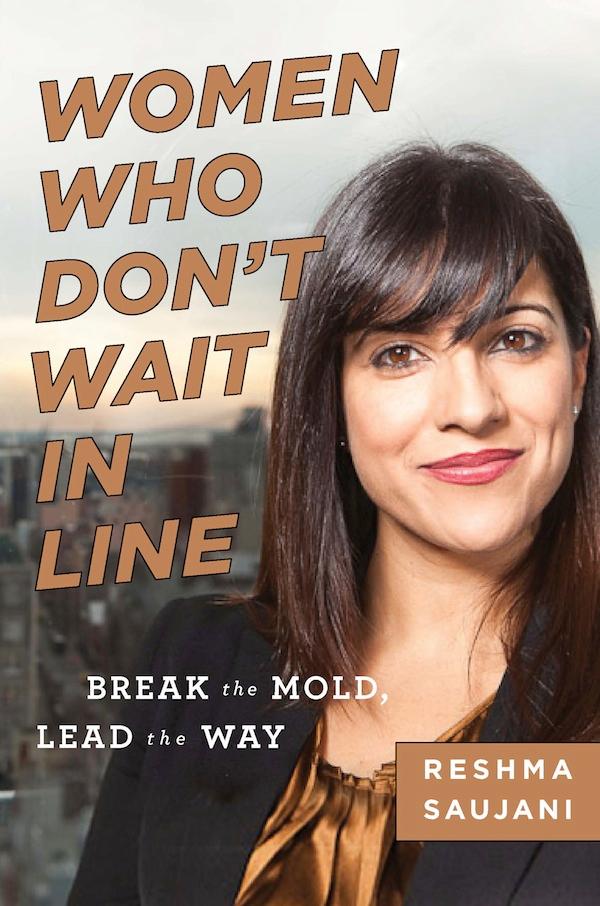Women Who Don’t Wait in Line

The following is an excerpt from “Girls Who Code” founder Reshma Saujani’s book “Women Who Don’t Wait in Line.”

Unapologetically Ambitious
When I decided to run for Congress, the political establishment accused me of jumping the queue. I was chided for not following what the New York Times called the “traditional political protocol of running for a lower office first,” accused of having “no credentials” by political consultants, and cautioned by politically connected women and men to “build my career” with a smaller seat, a city council race, a state legislature race. After all, wrote the Village Voice, “none of the 17 city representatives in the House went straight there without prior public service, almost all elected first, like Maloney, to the assembly, state senate or city council.”
To be sure, the how-to manual for getting elected has long promoted the concept of “wait your turn” — especially in a place like New York, with its powerful political machine. Candidates are taught to prepare through a series of “smaller seats,” so they can build up to play at the highest level. In part, it’s about gaining experience as an elected official — but it’s also about paying your dues to the establishment.
There is something to be said for investing as much time as you can in your profession and bolstering your skill set. It’s important to build real relationships with key stakeholders and earn a reputation within an industry.
I get that. Yet I still can’t help wondering: Is being an insider the best credential for bringing creative ideas and new initiatives to an industry in need of change? This certainly does not hold true for politics or any other profession. Some of the most successful people are those who have approached industry-specific problems from the point of view of an outsider, which freed them from long-held assumptions and allowed them to think outside the box. The world is a different place, and it’s not uncommon for women to move laterally between professions instead of linearly up the ladder. Individuals who don’t follow “the beaten path” often inject fresh perspectives into stale debates. We need new actors in every profession, with new ways of thinking and new relationships in their communities and beyond.

The Time Is Now
The “wait your turn” attitude can be especially pernicious toward women. “Know your place,” “hide your ambition,” and “wait your turn” are the kinds of messages that have been holding women back for much too long. By silently accepting these socials mores, we risk perpetuating the notion that our progress must be single file; that there can only be room in the arena for one strong woman at a time.
Too many women have been encouraged to overcommit to their preexisting activity or job, told to wait patiently for some arbitrary date, until they are “ready” to take the next step. But who’s to tell us when we’re ready? How can women make the best career choices for ourselves when we aren’t encouraged to dream big about our futures?
The women I most admire, like Eleanor Roosevelt and Hillary Clinton, did not make history by patiently waiting in line. Instead of waiting to be picked, they embraced their ambition and picked themselves. Perhaps it wasn’t immediate, but somewhere along their journey, they learned that waiting for opportunities to find them might mean coming up empty-handed.
These women understood the steep price of giving up their ambitions, not just for themselves but also for women as a whole. Institutional sexism and holding back have led women to earn less than our male peers, even though we work just as hard or harder. Playing it safe has led us into corners of boredom or depression at work because we have stuck with the safe and comfortable job instead of asking for a more challenging role with a bigger title. It’s also led to a lot of student loan debt, advanced degrees gone to waste, and dreams deferred because we are simply afraid to admit that we want more.
Had I run for a lower seat, I would have been praised for my good behavior. My caution would have been interpreted as a demonstration of political acumen. I might have even won. But it also would have gone against everything I believed — everything I wanted to change. So I’m glad I ran in the race I did, however disappointing the outcome. Dreaming big also means that sometimes you have to fail before you can succeed.
If we want to close the ambition gap, we have to start taking risks. Apply for the job you’re not qualified for! Women outnumber men in college enrollment and make up a greater percentage of the workforce, yet the number of women in leadership roles is a fraction of what it should be. The truth is, many women question their credentials and qualifications.
In 2011, 45.4 percent of all lawyers were women but only 19.5 percent of partners were women. Moreover, the women who made partner were not involved in the same kinds of lucrative deals as their male counterparts: Among partners credited for more than $500,000 in business, a mere 16 percent were women.
The same trends are revealed in medicine and business. In 2012, 34.3 percent of physicians were women, but more than 60 percent of those women physicians were in one of six specialties: internal medicine, pediatrics, family medicine, obstetrics/gynecology, psychiatry, and anesthesiology. Female doctors continue to be found in the lower-paying, more care-oriented fields. In 2008 only three of more than a hundred chairs of surgery in the United States were filled by women, and there have been only six female chairs in history.
In the business arena in 2011, women were only 14.1 percent of Fortune 500 executive officers and only 3.6 percent of Fortune 500 CEOs.8 In academia, the achievement gap is similar. The National Center for Education reports that 84 percent of U.S. schoolteachers are female, but according to the American Council on Education only 26 percent of university presidents are female. Further, a mere 44 percent of women are tenured professors, reports the American Association for University Women.9 Women are an overwhelming majority of all people working in education, but very few of them rise all the way to the highest ranks.





